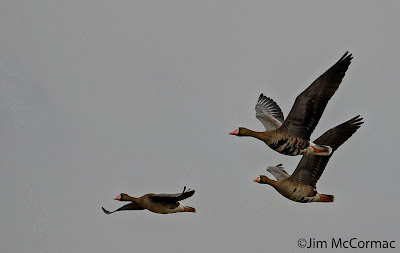As mentioned in the previous post, I spent the weekend past at the amazing Goose Pond in Indiana. You can read why, and see other photos from that foray, RIGHT HERE.
Two particular challenges face the photographer at Goose Pond, at least during our weekend. One is distance. This is a huge wide-open space, and waterfowl and other wild birds are not dummies. Getting within good range for tack-sharp photos can be tough. The other challenge was weather-related. Skies were heavy and gray the entire time, often delivering a wet mist or spitting rain. As much of photography is about light, such conditions are distinctly suboptimal, especially when shooting birds where fast shutter speeds are often a necessity. But as noted in the prior post, we probably learned more by having to work in these conditions.
Following are a few more photos from the Goose Pond weekend.
Hundreds of American White Pelicans mass in the distance. There were over 1,000 birds present; so many that the large roosts looked like distant snowbanks.
Occasionally small pelican squadrons would pass by on the wing near enough to shoot fairly well. Note the large "horn" or flattened tubercle atop their bills. American White Pelicans develop these odd bumps during the breeding season.
By FAR the most common waterbird in the marshes was the American Coot. Thousands of them were everywhere. They did make for good wingshooting practice.
A trio of Greater White-fronted Geese passes over. Hundreds were present. It was neat to see so many of these birds, which occur largely west of Ohio. The semi-musical piping squeaks of flocks filled the air on occasion.
In the previous post, I discussed the challenges of exposing birds in flight that are backdropped by a colorless leaden sky. To make this image, I cranked the exposure compensation two stops or so to the right (positive) to try and get a decent exposure. The end effect can be rather painterly.
A hen Green-winged Teal rockets by. These tiny ducks are a challenge to capture in flight. This one surprised me as it came from behind as I stood partially hidden amongst some cattails. I was using my Canon 7D Mark II with the superb 100-400 II lens, handheld. This was the first shot I got off, and the only keeper. This camera shoots ten frames a second on burst mode, and I kept the trigger down. But the bird saw me just about the time that I took this photo, and quickly veered off.
This one was luck, at least in part, depending upon your viewpoint. I shot it from the same cattail blind as the previous image, and was smoothly panning this flock of Redheads as they passed by my position. When I later evaluated the images, I saw that one of the birds was caught in the act of releasing a flume of fecal effluvia.
Several interesting questions are raised by this, on which I suspect there has been little to no research. Ducks in flight are fast, and these Redheads were probably doing 40 mph or faster. It would be distinctly disadvantageous to be a duck that was closely following a bird when it forcefully expelled. Have waterfowl evolved a staggered flight formation to avoid such mishaps? Do birds that must "go" when on the wing drop to the back of the pack as a matter of etiquette? Do they prank their comrades with an expected blast?
Goose Pond has become an important resting and refueling area for Whooping Cranes in the recently established population that winters in Florida, and migrates to Wisconsin. At least seven were present this weekend. While the giant white birds can be seen a mile away, and they're fun to watch, most of the time the cranes were too distant for photos. While the bird and its companion were fairly far off, they were close enough to get fairly clear images. I was using the equivalent of an 1120 mm lens, and even then much cropping was necessary. Note all the bands adorning its legs, and there was even a leg transmitter for radio telemetry monitoring.
We figured the meadows and marshlands of Goose Pond were harboring Short-eared Owls, and sure enough, we saw about five of the charismatic raptors at dusk on the first night. As is often the case with these largely crepuscular owls, they didn't emerge until it was too dark for decent photography. The camera's ISO was 6400 when I made this image - far too high for a crisp shot. But the photo does show the general ambiance of the scene, and we greatly enjoyed watching the owls' antics.
I look forward to a return visit to Goose Pond, someday.








3 comments:
Oh my--these were AMAZING photos. You really have talent!
How on earth anyone can focus on something in flight is beyond me.
I enjoyed these thoroughly---especially the pelican close-up in flight. Wow!
Thanks for sharing
Operation Migration says you have a "lovely photo of 18-03" referring to the Whooping Crane in your photo. Whooper number 18, born in 2003 and a member of the Ultralight population! And yes, a gorgeous photo of a rare bird!
Thanks for the interesting info, Lori!
Post a Comment